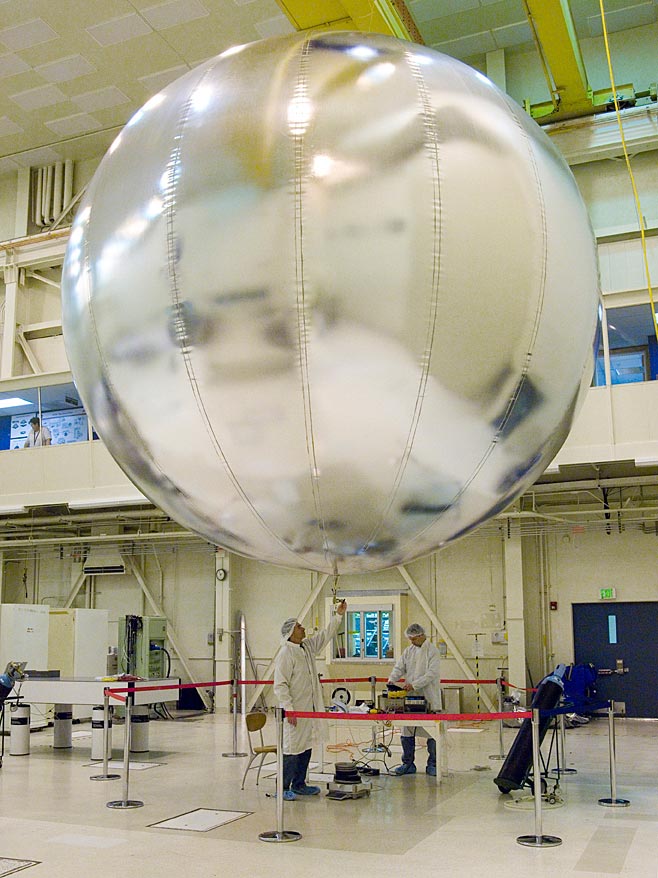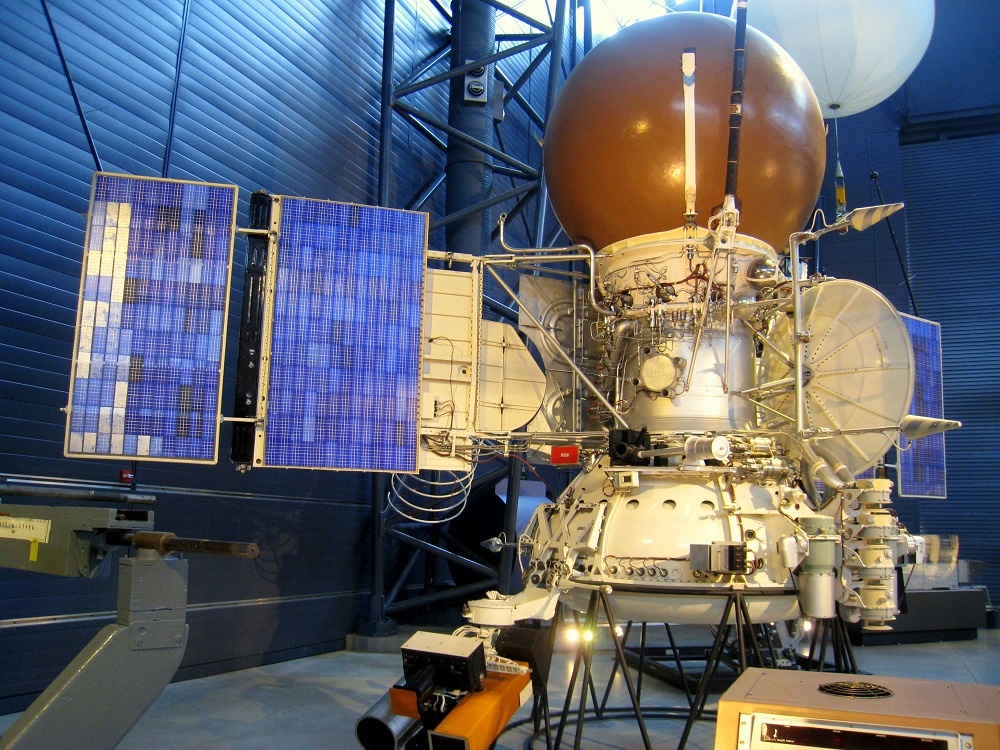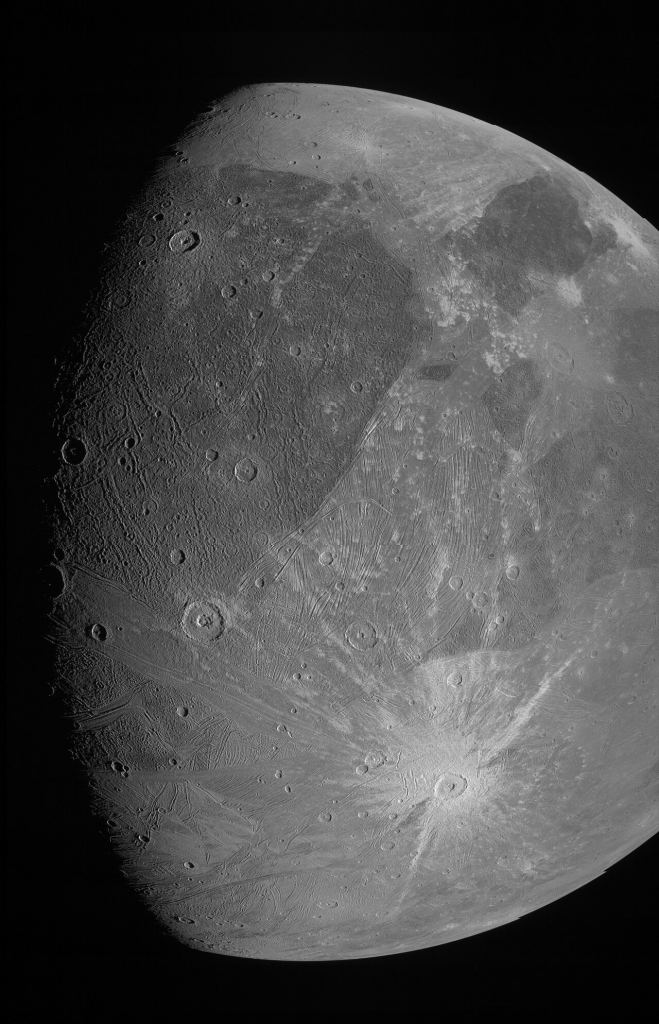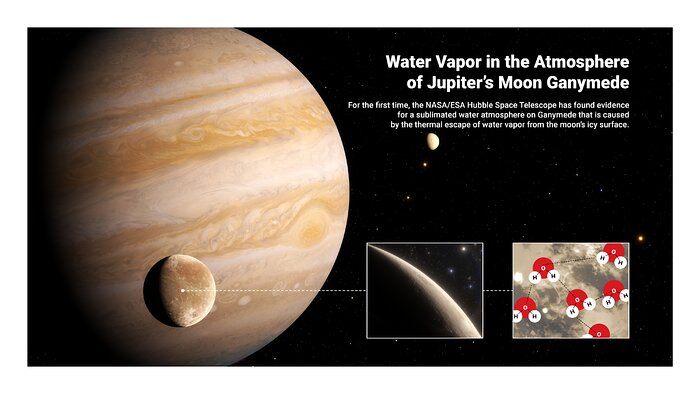Live coverage of the unpiloted test flight of Boeing’s Starliner crew capsule on the Orbital Flight Test-2 mission. Text updates will appear automatically below. Follow us on Twitter.
Space News & Blog Articles
Balloon Mission May Also Work to Detect Quakes on Venus
An opportunity in 2019 lays the groundwork for balloon-borne detectors on Venus, working to unravel a key mystery.
The skies of Venus may become a busy place in the coming decade, using technology field-tested here on Earth.
A team out of NASA JPL-Caltech hypothesized that terrestrial earthquakes should also produce low-frequency infrasonic sound waves, which would be transmitted from the ground through the atmosphere as changes in barometric pressure. These sound waves, while difficult to detect, should be measurable via highly sensitive barometers carried aloft.
One of the balloons from the study, in the field. NASA/JPL-CaltechThe team had a chance to put this idea to the test in 2019. In early July, a series of powerful earthquakes rattled the town of Ridgecrest, California. This was followed by over 10,000 aftershocks over the following six-week period. This gave the team the chance to fly instruments aboard four heliotrope balloons, rising to about 18 to 24 kilometers altitude with the warmth of the daytime Sun, and settling back to Earth at night.
Previous experiments detected deliberate human-made earthquakes caused by seismic hammers or explosives, but parsing out faint low frequency waves is magnitudes more difficult. Environmental noise—to include vibrations from the balloons themselves—all had to be accounted for.



This is how you get Tatooines. Binary Star Planet Formation
One of the less appreciated aspects of George Lucas’ vision for Star Wars was that he predicted the existence of planets in binary star systems years before we saw even the first exoplanet. Now a team from the University of Cambridge and the Max Planck Institute for Extra-terrestrial Physics have found how exactly those planets can form without being torn apart by their accompanying suns.
At this point, astronomers have found plenty of planets like Tatooine, orbiting around a binary star system. Kepler found around a dozen that orbit both stars in a binary, in addition to dozens of others that orbit at least one star in a binary system. But how exactly such worlds could form remained a mystery until recently.
UT video discussing multiple star systems.To solve that mystery, Dr. Roman Rafikov of Cambridge and Dr. Kedron Silsbee of Max Planck turned to computational physics models. Gravity in binary star systems can wreak havoc on planetary formation models, with the gravitational pull of one star destroying a protoplanet before it is able to amalgamate enough mass to truly be considered a planet. That same gravity can also disrupt the protoplanetary disks that planets can form out of.
But Drs. Rafikov and Silsbee found a very special set of conditions that still allows planets to form in such a harsh environment. In order to unlock the secret they studied the nearest binary star system – Alpha Centauri.
UT video discussing Breakthrough Starshot – a mission to get to Alpha Centauri.In our nearest stellar neighbor, the smaller star orbits around the larger one about once every 100 years. It’s a relatively stable gravitational dance, essentially what would happen if you replaced Uranus with a star and kept it on the same orbit. In such an environment there are two important variables needed for the formation of a planet.
Astronauts are celebrating their own Summer Olympics in space (satellites, too)
One of the biggest sporting events on Earth is being watched by those beyond our world.
Orionid meteor shower 2021: When, where & how to see it
Ganymede has been getting alot of attention lately. It was the co-star of a video from Juno recently, and now scientists found something to make it an even more intriguing place visit – water vapor.
It has been well known for years that Ganymede harbors water, and lots of it. In fact, the ninth biggest object in our solar system might hold more water than all of the Earth’s oceans combined. However, scientists previously thought that most of it had been either frozen on the moon’s surface or was potentially trapped as a liquid under massive ice sheets.
Updated image of Ganymede taken by Juno in June 2021.
Credit – NASA / JPL – Caltech / SwRI / MSSS
Most observations up to this point had confirmed that theory. But there was one that was a little bit off – two separate ultraviolet images that Hubble took of Ganymede back in 1998. Those, which can be seen as two different “colors” of ultraviolet light, gave scientists several insights. First, Ganymede had a magnetic field, which is similar to Earth’s in that there are auroral ovals around the moon’s poles. Second, there are molecules of O2 surrounding the planet, which accounted for other similarities between the two ultraviolet images. That also made sense, given that O2 can be stripped off the surface when a charged particle interacts with the ice there.
But there were some clear differences between the two images as well. Originally, scientists ascribed these differences to the presence of molecular oxygen in the atmosphere as well. Its absorption band could have accounted for the difference in reflection at the ultraviolet wavelengths Hubble used.



Matter From Light. Physicists Create Matter and Antimatter by Colliding Just Photons.
Future rockets could fly with tanks made of lightweight carbon fibre reinforced plastic thanks to ground-breaking research carried out within ESA’s Future Launchers Preparatory Programme.
Mariner 9: The Martian Semicentennial
Some astronomers suggest setting up a "SatHub" to address the growing threat that satellite megaconstellations pose to the night sky — but funding and support are necessary to make it happen.
NASA Chooses Falcon Heavy Over SLS to Launch Europa Clipper, Saving About $2 Billion
Retired NASA astronaut Karen Nyberg has teamed up with apparel company SvahaUSA to create a "Dinos in Space" clothing line.
We could hunt gravitational waves on the moon if this wild idea takes off
The moon is a great place to hunt for ripples in space-time, a new study argues.
China is building a new ship for sea launches to space
A Portland-area high school came out on top in a new "distributed" version of this year's American Rocketry Challenge that was optimized for pandemic safety.
ESA Web TV image for the launch of Eutelsat Quantum
Image: ESA Web TV image for the launch of Eutelsat Quantum
Watch the launch of Eutelsat Quantum
Follow the launch on 30 July of a sophisticated telecommunications satellite capable of being completely repurposed while in space.
SpaceX stretches rocket reuse record with another Starlink launch
ESA has successfully operated a spacecraft with Europe’s next-generation mission control system for the first time. The powerful software, named the 'European Ground System - Common Core' (EGS-CC), will be the ‘brain’ of all European spaceflight operations in the years to come, and promises new possibilities for how future missions will fly.
“All eyes on weather” for Friday test launch of Boeing’s Starliner crew capsule
Boeing’s Starliner spacecraft is stacked on top of a United Launch Alliance Atlas 5 rocket at Cape Canaveral. Credit: Boeing/Damon Tucci
The threat of lightning could thwart plans to launch an Atlas 5 rocket from Cape Canaveral Friday with a Boeing commercial crew capsule on an unpiloted test flight to the International Space Station, according to the forecasters on the Space Coast.
There is a 60% chance that weather could prevent liftoff at 2:53 p.m. EDT (1853 GMT) Friday, when the Atlas 5 has an instantaneous opportunity to launch on a trajectory to allow the Starliner spacecraft to intercept the space station Saturday.
If launch occurs on time, the Starliner spacecraft is set to dock with the station at 3:06 p.m. EDT (1906 GMT) Saturday. The capsule is scheduled to undock and return to Earth for a parachute-assisted landing in New Mexico on Aug. 5.
But that assumes weather cooperates for Friday’s launch attempt.
“It kind of feels like all eyes are on weather at this point,” said Will Ulrich, launch weather officer at the U.S. Space Force’s 45th Weather Squadron. “Anytime me and my colleagues see a launch being put on the schedule or on the calendar during the summer months from Kennedy Space Center or Cape Canaveral Space Force Station, we always have to be prepared for a challenge. And this particular launch is no different, especially given the time of the instantaneous launch window just before 3 p.m.”
Magnetic "Spoon" Feeds Supermassive Black Hole
The Space.com Forums are giving away a SpaceX Crew-3 prize pack to get ready for the planned Oct. 31, 2021 launch of four astronauts to the International Space Station.
25 weird and wild solar system facts
On Monday (July 26), astronauts said goodbye to a cornerstone of the International Space Station and captured stunning images of the compartment burning up in Earth's atmosphere.
SpaceX is about to begin launching the next series of Starlink satellites
A Starlink ground terminal. Credit: SpaceX
After going through July with no launches, SpaceX is scheduled to resume missions in August with Falcon 9 rocket flights from California and Florida to commence deployment of the next generation of Starlink internet satellites.
SpaceX is gearing up for at least two Starlink launches next month, beginning with a Falcon 9 mission departing from Vandenberg Space Force Base, California, no earlier than Aug. 10, multiple sources said. Another Falcon 9 launch is scheduled to carry a batch of Starlink satellites into orbit in mid-August.
They will be the first SpaceX launches since June 30, an unusually long gap in the company’s jam-packed launch schedule. The most recent Falcon 9 mission to carry a full load of Starlink satellites occurred May 26.
Since then, SpaceX has activated hundreds of internet spacecraft delivered to orbit on previous Falcon 9 missions, raising the number of operational Starlink craft from roughly 950 satellites to more than 1,300, according to an analysis by Jonathan McDowell, an astronomer at the Harvard-Smithsonian Center for Astrophysics and a widely-respected tracker of spaceflight activity
More than 200 additional Starlink satellites are drifting into their operational positions in orbit 341 miles (550 kilometers) above Earth at an inclination of 53 degrees to the equator.

Jeff Bezos asks NASA for moon lander contract, offers to cover billions in costs
Hot on the heels of its first crewed flight to suborbital space, Blue Origin reiterated that it wants a NASA moon lander contract — and stressed that it's willing to put a lot of its own money into the effort.
Fireball streaks across North Texas, creating light show and sonic boom
A fireball streaked across North Texas last night, leading to several hundred witness reports of a bright flash and sonic boom.
SpaceX retires giant net boats that caught rocket nose cones
SpaceX has retired its two rocket nose-cone-catching boats with their giant arms and nets.

